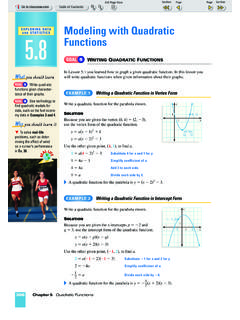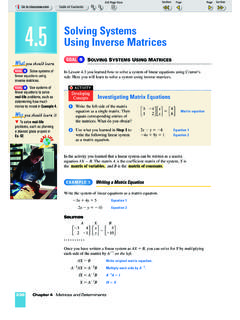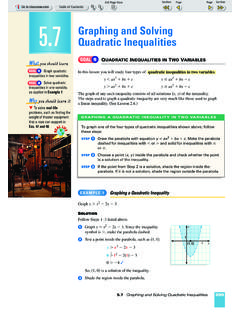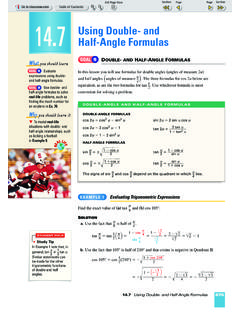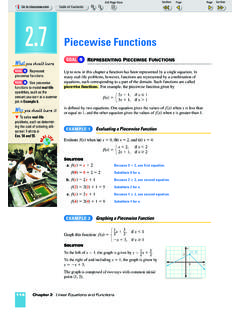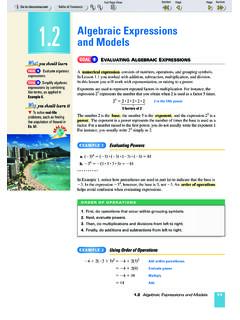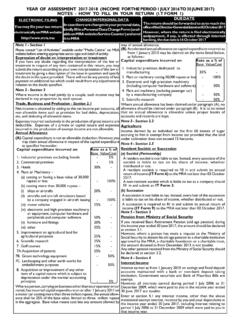Transcription of EXPLORING DATA AND STATISTICS Modeling with …
1 Page 1 of 2380 Chapter 6 Polynomials and Polynomial FunctionsModeling with Polynomial FunctionsUSINGFINITEDIFFERENCESYou know that two points determine a line and that three points determine a Example 1 you will see that four points determine the graph of a cubic a Cubic FunctionWrite the cubic function whose graph is shown at the the three given x-intercepts to write the following: (x) = a(x+ 3)(x 2)(x 5)To find a, substitute the coordinates of the fourth point. 15= a(0+ 3)(0 2)(0 5), so a= 21 (x) = 12 (x+ 3)(x 2)(x 5) CHECK Check the graph s end behavior. The degree of is odd and a < 0, so (x) + as x and (x) as x + ..To decide whether y-values for equally-spaced x-values can be modeled by apolynomial function, you can use Finding Finite DifferencesThe first three triangular numbers are shown at the right.
2 A formula for the nth triangular number is (n) = 12 (n2+ n). Show that this function has constant second-order the first several triangular numbers. Find the first-orderdifferences by subtracting consecutive triangular numbers. Then find the second-order differences by subtracting consecutive first-order 2finite 1 GOAL1 Use finitedifferences to determine thedegree of a polynomialfunction that will fit a set of technology tofind polynomial models forreal-lifedata, as applied inExample 4. To model real-lifequantities, such as the speedof the space shuttle in Ex. you should learn itGOAL2 GOAL1 What you should DATAANDSTATISTICSy42( 3, 0)(2, 0)(5, 0)x(0, 15)REALLIFEREALLIFE (1) (2) (3) (4) (5) (6) (7)1 36 1015212823456711111 Function values forequally-spaced n-valuesFirst-order differencesSecond-order differences (1) = 1 (2) = 3 (3) = 6 Triangular NumbersPage 1 of with Polynomial Functions381In Example 2 notice that the function has degree twoand that the second-orderdifferences are constant.
3 This illustrates the first property of finite following example illustrates the second property of finite with Finite DifferencesThe first six triangular pyramidal numbers are shown below. Find a polynomialfunction that gives the nth triangular pyramidal by finding the finite the third-order differences are constant, you know that the numbers can berepresented by a cubic function which has the form (n) = an3+ bn2+ cn+ substituting the first four triangular pyramidal numbers into the function, you canobtain a system of four linear equations in four (1)3+ b(1)2+ c(1) + d= 1a+b+c+ d= 1a(2)3+ b(2)2+ c(2) + d= 48a+4b+ 2c+ d= 4a(3)3+ b(3)2+ c(3) + d= 1027a+9b+ 3c+ d= 10a(4)3+ b(4)2+ c(4) + d= 2064a+ 16b+ 4c+ d= 20 Using a calculator to solve the system gives a= 16 , b= 12 , c= 13 , and d= 0. The nth triangular pyramidal number is given by (n) = 16 n3+ 12 n2+ 13 n.
4 EXAMPLE a polynomial function (x) has degree n, then the nth-order differences offunction values for equally spaced x-values are nonzero and , if the nth-order differences of equally-spaced data are nonzeroand constant, then the data can be represented by a polynomial function ofdegree OF FINITE DIFFERENCESf(1)f(2)f(3)f(4)f(5)f(6)f(7)1 4 10 20 35 56 84 3610152128345671111 Function values forequally-spaced n-valuesFirst-order differencesSecond-order differencesThird-order differences (1) = 1 (2) = 4 (3) = 10 (4) = 20 (5) = 35 (6) = 56 (7) = 84 HOMEWORK HELPV isit our Web extra 1 of 2382 Chapter 6 Polynomials and Polynomial FunctionsPOLYNOMIALMODELING WITHTECHNOLOGYIn Examples 1 and 3 you found a cubic model that exactlyfits a set of data points. In many real-life situations, you cannot find a simple model to fit data points you can use the regression feature on a graphing calculator to find an nth-degree polynomial model that best fits the with Cubic RegressionBOATINGThe data in the table give the average speed y(in knots) of the Tridentmotor yacht for several different engine speeds x(in hundreds of revolutions perminute, or RPMs).
5 A polynomial model for the data . the average speed of the Tridentfor an engine speed of 2400 engine speed produces a boat speed of 14 knots? the data in a graphing calculator andmake a scatter plot. From the scatter plot, itappears that a cubic function will fit the databetter than a linear or quadratic function. Use cubic regression to obtain a model. y= + CHECK By graphing the model in the sameviewing window as the scatter plot, you cansee that it is a good x= 24into the model from part (a).y= (24)3 (24)2+ (24) The Trident s speed for an engine speed of 2400 RPMs is about the model and the equation y= 14 onthe same screen. Use the Intersectfeature tofind the point where the graphs intersect. An engine speed of about 2050 RPMsproduces a boat speed of 14 4 GOAL2 Engine speed, x9111 3151719 speed, 12.
6 36 Y=14 MOTORBOATS often havetachometers instead ofspeedometers. Thetachometer measures theengine speed in revolutionsper minute, which can thenbe used to determine thespeed of the ONAPPLICATIONSPage 1 of what first-order differences and second-order differences many points do you need to determine a quartic function? can t you use finite differences to find a model for the data in Example 4? the cubic function whose graph passes through (3, 0), ( 1, 0), ( 2, 0),and (1, 2).Show that the nth-order finite differences for the given function of degree nare nonzero and (x) = 5x2 2x+ 16. (x) = x3+ x2 17. (x) = x4+ 2x8. (x) = 2x3 12x2 5x+3 Use finite differences to determine the degree of the polynomial function thatwill fit the a polynomial function that fits the a polynomial function that gives the number ofdiagonals of a polygon with the cubic function whose graph is ACUBICMODELW rite a cubic function whose graph passesthrough the given ( 1, 0), ( 2, 0), (0, 0), (1, 3)18.
7 (3, 0), (2, 0), ( 3, 0), (1, 1)19.(1, 0), (3, 0), ( 2, 0), (2, 1)20.( 1, 0), ( 4, 0), (4, 0), (0, 3)21.(3, 0), (2, 0), ( 1, 0), (1, 4)22.(0, 0), ( 3, 0), (5, 0), ( 2, 3) with Polynomial Functions383 Number of sides, n345678 Number of diagonals, d02591420 Vocabulary Check Concept Check Skill Check STUDENTHELPE xtra Practiceto help you masterskills is on p. (x) 1 3 35 15 39x123456 (x)6 152221 6 29x123456 (x)0 8 12 12 8 0x123456 (x) 1 4 38 35 84 Page 1 of 2384 Chapter 6 Polynomials and Polynomial FunctionsFINDINGFINITEDIFFERENCESShow that the nth-order differences for thegiven function of degree nare nonzero and (x) = x2 3x+724. (x) = 2x3 5x2 x25. (x) = x3+3x2 2x 326. (x) = x4 3x327. (x) = 2x4 20x28. (x) = 4x2+x+629. (x) = x4+5x230. (x) = 3x3 5x2 231. (x) = 3x2+4x+2 FINDING AMODELUse finite differences and a system of equations to finda polynomial function that fits the data .
8 You may want to use a dot patterns show pentagonal numbers. A formula for the nth pentagonal number is (n) = 12 n(3n 1). Show that thisfunction has constant second-order formula for the nth hexagonal number is (n)=n(2n 1). Show that this function has constant second-order first six square pyramidal numbers areshown. Find a polynomial function that gives the nth square pyramidal (x) 40 10264876x123456 (x)2 20 58 122 218 352x123456 (x) 3 8 15 21 2 3 18x123456 (x) 5 0 9 16 15 0x123456 (x)20 2 4 2 4 10x123456 (x)26 4 2 2 2 16x123456 (x)2 5 4 1 2 13x123456 (x)062612 10x123456 (x) 2 1 4 5 10 53x123456 (x) 2 6 6 4 30 78x123456 (x) 4 6 2 14 48 106x123456 (x)17 28 33 32 25 12 (1) = 1 (2) = 5 (3) = 14 (4) = 30 (5) = 55 (6) = 91 (7) = 140 STUDENTHELPHOMEWORK HELPE xample 1:Exs.
9 14 22 Example 2:Exs. 23 31, 44, 45 Example 3:Exs. 32 43, 46 Example 4:Exs. 47 49 Page 1 of 2 FINDINGMODELSIn Exercises 47 49, use a graphing calculator to find apolynomial model for the table shows the number of Girl Scouts (in thousands)from 1989 to 1996. Find a polynomial model for the data . Then estimate thenumber of Girl Scouts in table shows the average price (in thousands of dollars)of a house in the Northeastern United States for 1987 to 1995. Find a polynomialmodel for the data . Then predict the average price of a house in the Northeast table shows the average speed y(in feet persecond) of a space shuttle for different times t(in seconds) after launch. Find a polynomial model for the data . When the space shuttle reaches a speed ofapproximately 4400 feet per second, its booster rockets fall off. Use the model to determine how long after launch this friend has a dog-walking service and your cousinhas a lawn-care service.
10 You want to start a small business of your own. You aretrying to decide which of the two services you should choose. The profits for thefirst 6 months of the year are shown in the finite differences to find a polynomial model for each want to choose the business that will make the greater profit inDecember (when t= 12). Explain which business you should choose and the expressions x, x+ 1, x+ 2, .. , x+ 5 for xin the function (x) = ax3+ bx2+ cx+ dand show that third-order differences are data below can be modeled by a cubic function. Set the variableexpressions you found in part (a) equal to the first-, second-, and third-orderdifferences for these values. Solve the equations to find the coefficients of thefunction that models the data . Check your work by substituting the originaldata values into the with Polynomial Functions385t1989 1990 1991 1992 199 31994 1995 1996y231 1988 1989 1990 1991 1992 199 31994 1995 (x)140 149 159 169 169 34 56 (x) 1 1 3 7 5 9 Month, t123456 Profit, P 3522 54 101 16 3 Month, t123456 Profit, P 321 41 68 107 16 3 TestPreparation ChallengeEILEEN COLLINSwas selected byNASA for the astronautprogram in 1990.
